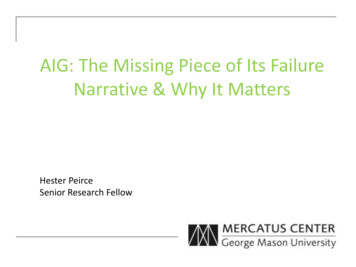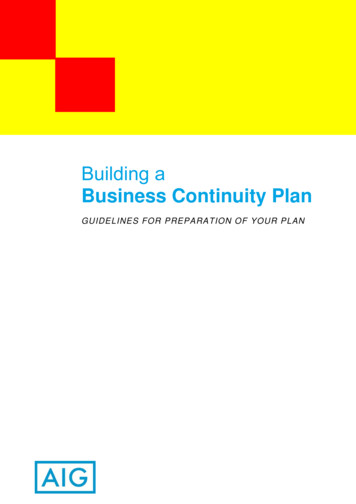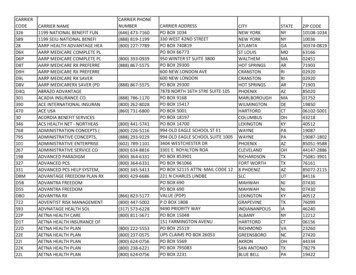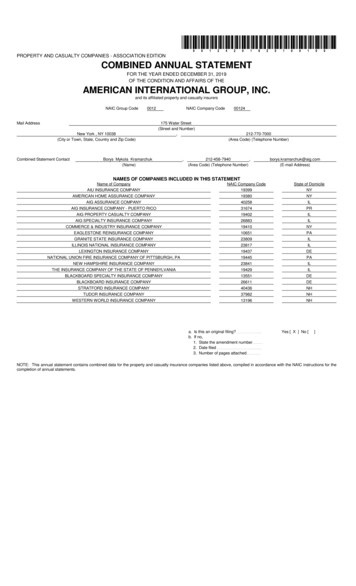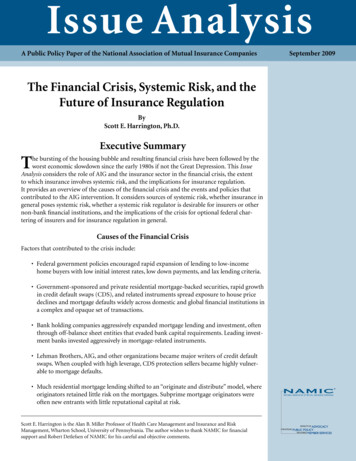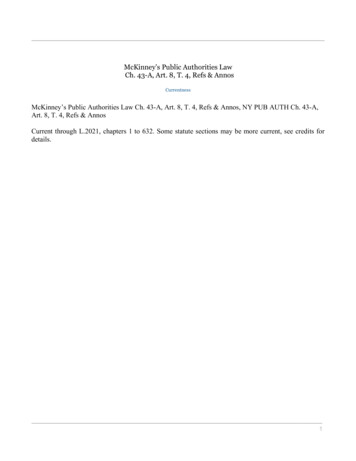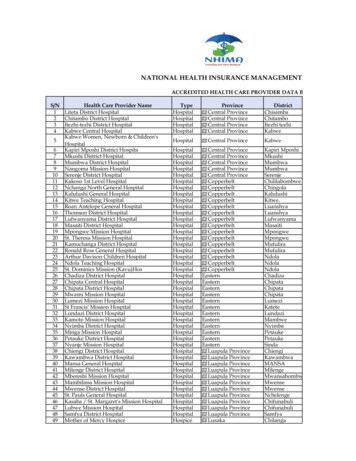
Transcription
Patient Safety; Hospital RiskPerspectives of Hospital C-Suite and Risk ManagersApril 2013www.aig.com/us/prevention
IntroductionAIG’s experience as a risk management partner to over 2,000 hospitals around the world tells usthat patient safety is a top concern for hospital executives. To better serve our clients, we wanted togo deeper. So we designed a study that asks, “Why?” What drives patient safety? Are there barriersour healthcare system must overcome to ensure a safer environment in the short-term? What can bedone to keep hospitals safer over the next three to five years?We’re delighted to share the results and implications of this C-Suite and Risk Manager survey withyou today.At AIG, we believe that combining our expertise with data-driven insights, like those found in thisstudy, can help bring on better tomorrows. Prevention doesn’t cost. It pays.When insurers work to understand and ultimately improve healthcare outcomes at the patient levelacross the system, which drive cost, it results in patients who: experience less pain, quicker recovery time and fewer medical complications; may return to their family and to work sooner; and are prescribed the right amount and type of medication, for the right amount of time.Whether helping make hospitals safer for patients, helping make construction sites like the WorldTrade Center safer for workers or educating parents on how to avoid concussion injuries at the littleleague ballpark, AIG is committed to bringing on healthier, longer lives.Russell M. JohnstonCasualty Product Line Executive, US and CanadaAIG Property Casualty2 Patient Safety; Hospital Risk
Marty Makary, MD, MPHAIG is proud to have worked with Marty Makary, MD, MPH as an advisor on this study. Dr. Makary’srole was ideal given his leadership at the United Nations’ World Health Organization (WHO)to measure hospital complications and as the first to publish studies on the use of a checklist insurgery.He has authored 150 publications, a leading textbook on surgery and a New York Times bestselling book, Unaccountable, advocating for more transparency in the healthcare system.Dr. Makary’s consulting contributions to this study included:1 drafting the questionnaire; approving the sample; reviewing the results, and editing the final report.Marty Makary, MD, MPHPatient Safety Expert1. Dr. Makary’s role with AIG is that of an independent consultant. Johns Hopkins has no role in AIG’s survey of Hospital C-SuiteExecutives and Risk Managers on patient safety.Patient Safety; Hospital Risk 3
Executive SummaryHospital C-Suite Executives and Risk Managers agree that patient safety is their number one priority.They also agree that failing to maximize financial sustainability is their number one threat. Byexploring the tension between these competing demands, as well as the environmental barrierstoward progress to improve safety and reduce risk, this report provides actionable data andinformation to support continuous improvement.The purpose of this survey was to better understand: What drives hospital leaders’ main priority, patient safety? What are the barriers the healthcare system must overcome to improve patient safety? What can be done to keep patients safer in hospitals over the next three to five years?In exploring these questions, four themes emerged:1. Patient safety and financial sustainability challenge hospital C-Suite and Risk Managers fortheir time and attention. A majority of hospital executives see patient safety as their top priority.At the same time, an equal amount view failing to maximize financial sustainability as theirbiggest threat.2. Who is “responsible for” patient safety and who “owns” patient safety do not fall within thesame role at the hospital. Virtually all executives agree that patient safety is the responsibilityof everyone in their hospital, but half say that nurses “own” it, with only 4% of each groupidentifying physicians as most responsible. Despite the responsibility they place on nurses, theC-Suite nonetheless think that nurse turnover rates are among the least influential items onoverall issues of hospital risk and patient safety.3. “Lack of teamwork, negative culture and poor communication” is the number one barrierto ensuring a safe environment for patients. Nine out of 10 executives believe that anemphasis on safety has to come from the top for it to be truly effective. When asked to describein their own words the barriers to patient safety, a plurality of executives give answers relatedto a lack of teamwork and a negative culture. Communication is also seen as a problem onseveral levels—from nurses fearing retribution for speaking up about patient safety issues todocumentation burdens to the number of patient “handoffs” among hospital staff inhibitingeffective communication.4 Patient Safety; Hospital Risk
4. Perceived “enhancements” to patient safety—such as technology, regulation and metrics—can have the opposite effect. According to the survey, many hospital leaders believe thattechnology can focus clinicians’ attention away from the examination table to the machinebeside the bed. Regulation is sometimes perceived to require reporting facts and figures thatmight be arbitrary to improving patient safety. Uniform metrics for patient safety have notbeen established collaboratively among all stakeholders, and often incentivize “teaching forthe test” rather than actually improving patient safety. Patients are left to decipher the meaningof patient safety metrics by themselves with questionable success.The remainder of this report contains three sections: (1) a discussion of the research findings;(2) trends that will shape patient safety over the next three to five years; and finally, (3)implications.Patient Safety; Hospital Risk 5
I. Competing GoalsPatient Safety and Financial Sustainability Challenge Hospital C-Suite and RiskManagers for Their Time and Attention.Two goals—ensuring patient safety and maximizing financial sustainability—compete for executiveattention in hospitals today. Two thirds of hospital leaders surveyed report that maximizingpatient safety is their top priority. Nearly two thirds also say that failing to maximize financialsustainability is the biggest threat to their hospitals this year. The tension that arises betweenthese competing goals can be seen in the time that hospital leaders devote to each. Maximizingfinancial sustainability was the lowest priority for both C-Suite Executives and Risk Managers, buta disproportionate amount of time was consumed in dealing with what they perceive as threatsto the bottom line. Only 2% of the C-Suite considered maximizing financial sustainability as theirhighest priority, but 16% of their time was devoted to this goal (a time/priority ratio of eight). Incontrast, 64% of the C-Suite ranked maximizing patient safety as the highest priority, while 33%of time was devoted to this goal (a time/priority ratio of about half).The need to address each goal is high1 and the resources to do so are limited2. Both goalsconflict again as hospitals strive to ensure an overall high-quality experience for their patients—anew metric for reimbursement.#1#1 PriorityPriorityPriority vs. Threat vs. Time Spent on EachMaximizingMaximizingpatientsafetypatient safety Priority v. Threat(Size Representative of Time Spent)Includes data for C-Suite and RiskManagers combinedMaximizingMaximizingqualitypatientquality rall hospitaloverall hn LT, Corrigan JM, Donaldson MS, (eds). To err is human: building a safer health system. National Academy Press; 1999.Landrigan CP, Parry GJ, Bones CB, Hackbarth AD, Goldmann DA, Sharek PJ. Temporal trends in rates of patient harmresulting from medical care. N Engl J Med 2010; 363: 2124-34.6 Patient Safety; Hospital Risk
I. Competing GoalsThe data further reveal how all four of these prioritiescompete with each other. For example, both C-SuiteExecutives and Risk Managers say that three of theirpriorities—managing financial sustainability, maximizingquality patient care and maximizing patient safety—alsorepresent three of their greatest challenges in achieving theirfourth priority—minimizing overall hospital risk.“Financial stability ismeeting the bottomline while makingimprovements tomaintain safety.” Risk ManagerPriorities compete with one another.They challenge minimizing overall risk Challenges to Minimizing Overall Hospital RiskC-SuiteMaximizing financial sustainability87%Implementing changes based onthe healthcare reform bill85%Implementing changes based onthe healthcare reform bill82%Staff communication84%Maximizing quality patient care81%Maximizing financial sustainability80%Maximizing patient safety79%Maximizing quality patient care80%Staff communication78%Maximizing patient safety79%RiskManagersA9. Please indicate which of the following are challenges your hospital faces in minimizing overall hospital risk. Please also indicate if the item isnot a factor/not applicable to your hospital. [MULTIPLE RESPONSE] (split sample; n 126 C-Suite, n 93 Risk Managers).and maximizing patient safety.Challenges to Maximizing Patient SafetyC-SuiteImplementing changes based onthe healthcare reform bill73%Maximizing financial sustainability72%Staff communication77%Maximizing quality patient care70%Maximizing financial sustainability68%Maximizing quality patient care71%Minimizing overall hospital risk69%Implementing changes based onthe healthcare reform bill67%Staff communication68%Minimizing overall hospital risk65%RiskManagersA10. Please indicate which of the following are challenges your hospital faces in maximizing patient safety. Please also indicate if the item is nota factor/not applicable to your hospital. [MULTIPLE RESPONSE] (split sample; n 126 C-Suite, n 93 Risk Managers).Nine percentage point differencebetween C-Suite Executives and RiskManagers on the challenge of staffcommunicationPatient Safety; Hospital Risk 7
II. Who Is In Charge?Who is “Responsible for” Patient Safety and Who “Owns” Patient Safety do not Fallwithin the Same Role at the Hospital.Despite the fact that ensuring patient safety is the highest priority for respondents, the studyreveals inconsistent perceptions of who is ultimately responsible. Virtually all hospital executives(98% of both C-Suite Executives and Risk Managers) agree that “every staff member in myhospital is responsible for patient safety.” But half of both C-Suite Executives and Risk Managers(52% and 51%, respectively) believe that nurses “own” it. Additionally, nine out of 10 C-SuiteExecutives agree that an emphasis on safety must come from top leadership for it to be trulyeffective—yet only about three fourths of executives report that their hospitals have executivewalk-rounds programs, and in those hospitals that do have such programs, 88% of the C-SuiteExecutives and 78% of the Risk Managers indicated that they personally participate. These datashow that responsibility is beginning to flow uphill but it is a difficult climb.Most Responsible for Patient SafetyC-Suite52% 51%19%*9% 11%Nursing/clinicalstaffThe C-Suite16%Riskmanagementand patientsafetydepartments12%7%Everyone onstaff(volunteeredresponse)4% 4%Medical staff All of the above(volunteeredresponse)Nursing/clinicalstaff accountabilityoutweights medicalstaff*Statistically significant difference between C-Suite and Risk Managers8 Patient Safety; Hospital Risk4% 5%Risk Managers2% 3%1% 0%OtherDon'tknow/refused(volunteeredresponse)
II. Who Is In Charge?C-Suite Executives, risk management/patient safety departments and medical staff are seen bysurvey respondents as being most influential on overall hospital risk, including issues of patientsafety. Interestingly, these executives see nursing staff turnover as one of the least influentialitems on overall hospital risk, including patient safety, regardless of the fact that they place theonus of patient safety on nurses.Influential Internal Entities: Top Three Box(8-10 on 10-point Scale)74%67%64%56%63%60%C-Suite50%*Medical staffRisk Managers59% nagementdepartmentLocal patientsafety culture41%48%38%Board ofTrustees29% 29% 31%Nursing/clinicalstaff turnoverratesFinancialdepartment24% 26%LegaldepartmentOutside organizations such as federal government agencies, accrediting bodies and stategovernment agencies add further nuances to the goal of maximizing patient safety in hospitals.These organizations, or external influencers, are beyond the control of the hospitals, yet are seenby hospital executives as highly influential on overall hospital risk.75%*62%Influential External Entities: Top Three Box(8-10 on 10-point Scale)74%66%71%64%C-SuiteRisk Managers61%51%38%30%29%24%13% 13% 11% 14% ExternalInsurancegovernment agencies that carriersagenciesestablishsafety andqualitybenchmarksPatient safetyexperts oradvocacygroupsInsurancebrokers5%Outside legal The mediacounsel10%*3%FoundationsThe role of these outside organizations on hospital risk, in conjunction with the lack of claritywithin hospitals regarding responsibility for patient safety, further complicates the question of“who’s in charge?”*Statistically significant difference between C-Suite and Risk Managers.Patient Safety; Hospital Risk 9
III. How Can the “Right Tone” Be Set?Negative Hospital Culture Is the Number One Barrier to Patient Safety.Barriers to ImprovingPatient Safety, Unaided**42%55%*Lack of teamwork/negativeculture and communication22%15%Lack of staff18%14%Financial thingDK/refusedThis may in part be due to the fact that, as notedby 51% of C-Suite Executives and 48% of RiskManagers, patient safety is defined differently bydifferent people across their hospitals. How canthe “right tone” be set? If results from this studycan serve as a guide, one approach would be toimprove elements in the hospital culture, such asteamwork and %3%Risk Managers“Patient safety is defined differently bydifferent people across my hospital.”% who agree51%48%C-SuiteAccording to the survey, the number one barrier topatient safety is lack of teamwork, negative cultureand communication. The majority of hospitalexecutives in this study (96%) believe that theirhospitals have a culture of patient safety. However,over one third of the executives acknowledge thattheir hospital needs to undergo major changes inorder to maintain a true culture of patient safety inthe future.According to the study, hospital executives oftenreport lack of teamwork, negative culture andpoor communication as the greatest barrier toimproving patient safety (42% of C-Suite Executivesand 55% of Risk Managers). The importance ofdiscussion amongst hospital colleagues cannotbe overstated: three fourths of Risk Managerssee staff communication as their top challengein maximizing patient safety in their hospital (asdo 68% of C-Suite Executives). Communicationmay also break down over issues of trust: 26% ofC-Suite Executives and 29% of Risk Managers saythat nurses fear retribution if they discuss potentialsafety problems with management.Risk Managers*Statistically significant difference between C-Suite and Risk Managers.**Responses are “unaided,” meaning they were provided by the respondentwithout the bias of a pre-selected list of options.10 Patient Safety; Hospital Risk
III. How Can the “Right Tone” Be Set?Whether it’s in the operating room, the emergencyroom or the board room, communication cansometimes be less than ideal, despite the best ofintentions. In this study, most respondents (5969%) agree that the quality of coordination andcommunication between departments at theirhospitals presents a challenge for maximizingpatient safety. Both C-Suite Executives (56%) andRisk Managers (61%) believe that an increase inthe number of clinical staff who touch a patient, i.e.the number of handoffs, makes communicationmore difficult and potentially compromises patientsafety. As one risk manager put it, “The barriersare the communication with the healthcare team.The handoff from one unit to another and fromone physician to another physician or nurse is ahard transition for the patient.”Forces on Patient SafetyManagement does not adequatelyaddress and communicate physicianperformance or behavior issues withthe medical staff leadershipCulture Confusion% who agree96%Patient safety is defineddifferently by differentpeople across my hospitalMy hospital needs toundergo major changes inorder to have a true cultureof patient safety51%48%33%37%C-SuiteRiskManagersC-Suite % Risk Managers %The number of clinical staff who touch apatient (i.e. the number of “handoffs”)makes effective communication difficult56% 61%34% 29%Medical staffleadership doesnot adequatelyassess andcommunicateperformanceissues via thepeer reviewprocessManagementdoes notunderstandthe issuesfaced by themedical staff22%* 11%38% 33%Management does not have timeto focus on medical staff issues96%My hospital has a culture ofpatient safetyNurses fear retribution if they discuss potentialsafety problems with management18%* 10%26% 29%*Statistically significant difference between C-Suite and Risk Managers.Patient Safety; Hospital Risk 11
IV. First, Do No HarmPerceived “Enhancements” to Patient Safety Can Have the Opposite Effect.Executives surveyed at nearly all hospitals (99-100%) emphasized hand-washing and infectionprevention as critical to maximizing patient safety.1Beyond these standard procedures, hospitals haveadded new processes, metrics and technology—sometimes in response to regulation—to improvepatient safety outcomes. Though well-intentioned,these new methods have in some cases introducedunintended negative effects on patient safety.Effects of Reporting External Metrics% who agreeHaving to report specificexternal quality metrics hasbeen effective in improving myhospital's overall safety75%89%*Having to report specificFor example, on one hand, increased regulation20%*external quality metrics hashas forced greater transparency and reportingnegatively impacted other8%areas of qualityof external quality metrics. Three quarters ofC-Suitesurveyed C-Suite Executives see reporting of5%Don't know/refusedquality metrics as beneficial to safety. On the(volunteered response)Risk3%Managersother hand, one in five believes that it producesnegative impacts on other areas of quality(compared with 8% of Risk Managers). The data further show that requiring reporting on certainmetrics might not always have the anticipated effect of improving patient safety, with one in fourexecutives admitting that their hospital is morefocused on publicly reported metrics than onMetrics Can Be Confusing andtruly improving patient safety. These data implyCounterproductivethat mandatory reporting forces some hospitals% who agreeto focus on the outputs they are required toThe public does not understand83%how to interpret publicly(“checking off boxes” on the metrics list), rather89%reported patient safety metrics.than the intended outcome of maximizingThere is widespread frustrationpatient safety. In an era where the public73%in our society with a lack ofexpects to have information available at their70%transparency in healthcare.fingertips through a quick internet search, theIn my hospital, there is aC-Suiteeasy availability of healthcare statistics online—21%concern that greatertransparency will lead to24%regardless of whether those statistics are valid—Riskreduced patient volume.Managersis likely empowering more patients to focus onpublicly reported metrics, rather than the true*Statistically significant difference between C-Suite and Risk Managers.1.See Also: Boyce JM, Pittet D. Guideline for Hand Hygiene in Health-Care Settings. Recommendations of the Healthcare InfectionControl Practices Advisory Committee and the HICPAC/SHEA/APIC/IDSA Hand Hygiene Task Force. Society for Healthcare Epidemiology of America/Association for Professionals in Infection Control/Infectious Diseases Society of America. MMWR Recomm Rep2002;51(RR-16):1-45.12 Patient Safety; Hospital Risk
IV. First, Do No Harmimpact those metrics have on patient safety. Most executives (73% of C-Suite Executives and 70%of Risk Managers) agree that there is widespread frustration with the current lack of transparencyin healthcare, regardless of the fact that reporting requirements have been increased. Mostrespondents (83% of C-Suite Executives and 89% of Risk Managers) also believe that the publicdoes not understand how to interpret publicly reported safety metrics, uncovering a critical needfor patient education.Technology is another area where one mightexpect to see healthcare reaping easy benefitsto improve patient safety, but respondentssay this could come at the expense of qualitypatient care.Technology: A Help and a Hurdle% who agreeMy hospital effectively usestechnology to improve patientsafety outcomes84%88%Costly, newly acquired healthcare technologymay be more of a hindrance than a help, as59%Technology takes clinical staffaway from patient caretechnology can literally and figuratively stand53%between a caregiver and a patient, diminishingMy hospital is unable to invest inC-Suitethe more personalized care that a patient may36%technology that could behave once received. This further compoundseffective in improving patient34%Risksafetythe problem of effective communication,Managersmentioned earlier in the report as the topbarrier to patient safety. While most agreetheir hospital effectively uses technology toimprove patient safety, more than half the surveyed executives say it takes clinical staff away frompatient care, and more than one third say their hospital is unable to invest in technology thatcould improve patient safety.Lack of time is another challenge to patient safety, and time is typically fragmented betweeneducation and management of problematic behavior. The biggest time-related challengesinclude documentation burdens, time needed to educate staff about patient safety andmaintaining consistency of patient care.Time-related Challenges to Maximizing Patient Safety69%60%DocumentationburdensC-Suite54%50%43% 41%The time needed Maintainingto educate staff consistency ofabout samongdoctors35%27%Addressingperformance orcompetencyissues amongdoctors34% 33%Risk Managers30%34%PromotingUncovering theaccurate androot cause oftimely reporting adverse safetyof adverse eventseventsPatient Safety; Hospital Risk 13
Trends Shaping Patient SafetyRespondents Identified Several Trends that Will Help Shape Patient Safety Over the Next Three toFive Years.1. New emphasis on “Patient Satisfaction” may complicate efforts to improve patient safety.Though safety will continue to be a priority, it may be further complicated by externalpressures to focus on the overall patient quality care experience—as measured by public“patient satisfaction” metrics. In its simplest form, success in patient safety is defined by thissurvey’s respondents as “keeping patients free from harm,” with far fewer C-Suite Executivesand Risk Managers defining it as “patient satisfaction:” 75% of C-Suite Executives and RiskManagers define success in patient safety as “no errors/falls/harm endured,” while just15% of the C-Suite Executives and 13% of the Risk Managers surveyed define it as “patientsatisfaction.” As one risk manager notes, “Patient safety is where risk and quality overlap witha goal of improved quality care and the prevention of adverse events.”2. Industry metrics will be meaningful only if they are consistent across all stakeholders.In the future, we will see patient safety definitions emerge from industry metrics thatare consistent, that can be operationalized and that are understood both internally andexternally. Future success will require a coordinated effort among internal (C-Suite, RiskManagers and clinical staff) and external (patients and the government) parties.3. Transparency threatens to reduce patient volume.Transparency and collaboration will bringchallenges—namely, a demand for more metrics byexternal agencies and a lack of patient guidance/education. Without information, an under-informedpublic becomes a fiscal challenge for hospitals.There is a concern that data is perceived as morecredible when it is involuntarily versus voluntarilyreported, and that greater transparency will lead toreduced patient volume.14 Patient Safety; Hospital Risk“Success in patient safetyis demonstrated in lackof errors, patient safety,prevention of anyunexpected outcome.” C-Suite
Trends Shaping Patient Safety4. Pressure on financial sustainability will not ease.Financial sustainability will continue to be at the forefront of challenges facing hospitalleaders, and will remain critically intertwined with patient health over the next three to fiveyears. We can expect to see increasing focus on patient satisfaction metrics, which impactconsumer demand and pressure to implement healthcare reform.Insurance companies can play a critical role in navigating these competing challenges byworking as a trusted advisor, facilitator and educator to hospital leaders, Risk Managers,medical staff, nurses and patients.Definitions of Success in Patient Safety, Unaided*No errors/falls/harmendured75%75%15%13%Patient satisfactionGood average/lowOtherDon't know/refused2%3%12%9%2%2%C-SuiteRisk Managers*Responses are “unaided,” meaning they were provided by therespondent without the bias of a pre-selected list of options.Patient Safety; Hospital Risk 15
Implications1. Patient safety and financial sustainability should be complementary goals, not competingobjectives. Given that nearly half of every dollar spent on healthcare costs is related to a medicalmistake, improvements in patient safety will have a quick return on investment and ease financialburdens.2. Strategies to relieve the “safety versus finance” tension should be explored at the executive levelto set a deliberate focus and course. The survey reveals that both C-Suite Executives and RiskManagers have the same top priority (patient safety) and the same top threat (ensuring financialsustainability). However, neither group is dedicating the majority of their time on either goal.3. Hospitals should seek to define and establish clear responsibility for patient safety. To havepositive outcomes, patient safety must be a multi-disciplinary goal.4. Executives need to walk the talk and set the tone for a consistent culture of patient safety whereopen communication is not only valued but expected. Everyone, from doctors to nurses, C-Suiteto support staff, needs to “own” patient safety. Everyone, not just patient safety departments andthe C-Suite, needs to be able to influence the culture, as well as the deployment of safe patientcare. Everyone who touches a patient is equally responsible for patient safety. Anyone whoidentifies an issue with patient safety must feel free to discuss that issue for the benefit of patientsafety without fear of retribution.5. All stakeholders/disciplines need to engage in a thoughtful, collaborative and strategic approachto creating effective tools and processes for improving patient safety and reducing the potentialfor adverse outcomes.6. Insurance carriers can play a larger role in patient safety. For example, they can provide servicesto assess a hospital’s patient safety culture and program components.Our MethodologyEdelman conducted a 15-minute, computer-assisted telephone survey among 250 hospital C-SuiteExecutives and 100 Risk Managers in hospitals across the US. The survey was conducted fromNovember 13 through December 20, 2012. With 95% confidence, the margin of sampling erroris /-5%. The study was comprised of core questions measuring attitudes and behaviors related topatient safety and hospital risk. The study then further looked at the complexities of patient safetyexploring internal and external challenges with half of the respondents, and key influences andtransparency with the other half.16 Patient Safety; Hospital Risk
AIG175 Water StreetNew York, NY 10038prevention@aig.com www.aig.com/us/preventionAmerican International Group, Inc. (AIG) is a leading international insurance organization serving customers in more than 130 countries. AIG companies serve commercial, institutional,and individual customers through one of the most extensive worldwide property-casualty networks of any insurer. In addition, AIG companies are leading providers of life insuranceand retirement services in the United States. AIG common stock is listed on the New York Stock Exchange and the Tokyo Stock Exchange.AIG is the marketing name for the worldwide property-casualty, life and retirement, and general insurance operations of American International Group, Inc. For additional information, pleasevisit our website at www.aig.com. Products and services are written or provided by subsidiaries or affiliates of American International Group, Inc. Not all products and services are availablein all countries, and insurance coverage is governed by actual policy language. Certain products and services may be provided by independent third parties. Insurance products may bedistributed through affiliated or unaffiliated entities. Certain property-casualty coverages may be provided by a surplus lines insurer. Surplus lines insurers do not generally participate in stateguaranty funds and insureds are therefore not protected by such funds.
To err is human: building a safer health system. National Academy Press; 1999. 2. Landrigan CP, Parry GJ, Bones CB, Hackbarth AD, Goldmann DA, Sharek PJ. Temporal trends in rates of patient harm resulting from medical care. N Engl J Med 2010; 363: 2124-34. Patient Safety; Hospital Risk. 7 .

